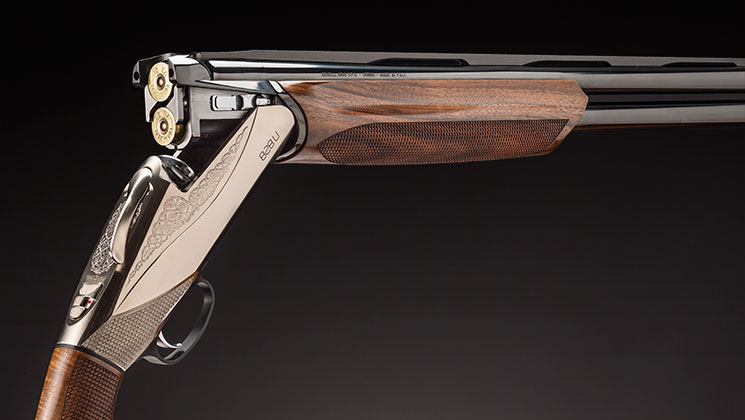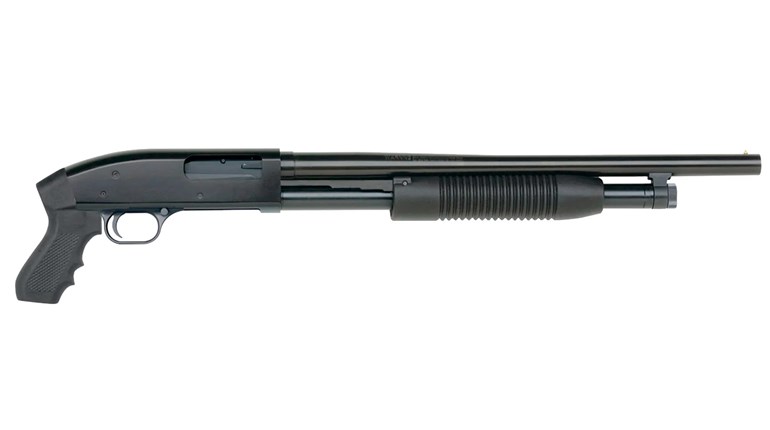
I thought Benelli had gone bat-crazy when it unveiled its new shotgun earlier this year. That’s because it featured two stacked barrels and a wooden stock. No magazine was to be found. I’m a fan of over/under shotguns, but I knew this relatively small market to be jammed with guns from companies that have been building them for a long time—or in the case of Benelli’s parent company, Beretta, eons. Meanwhile, Benelli virtually owns the high-end semi-auto hunting market … why would it shift its focus?
Then I handled the 828U. I hit 21 clays in a row on the skeet field before missing my first. That’s when I stopped to appreciate the radically designed new 12-gauge in my hands. Right then I knew what Benelli was thinking—precisely the opposite of my initial notion. Because the company has such a handle on the semi-auto market it can afford to focus on a new category, and because it’s a newcomer to over/unders, its design team wasn’t hampered by the status quo of tradition.
My skeet gun of choice is an old 6.8-pound Beretta BL-4. A grouse gun at heart, its hard plastic buttpad punishes me on the clays course, and it’s loose as a goose with wear, but because it fits me and I can hit with it, I use it. Yet after four boxes through the 6.8-pound 828U, recoil didn’t cross my mind. You might read somewhere that recoil mitigation is marketing hype, that Newton’s laws of motion are absolute. While it’s true that the laws of physics are unwavering, recoil energy and perceived recoil are two different things. If you were going to take a hit in the face from Floyd Mayweather, would you rather he tape a pillow to his fist first? Of course you would.
Same goes with shotguns. Despite the 828U’s weight that makes it great for upland marches, it’s soft enough to shoot all day at the range thanks to its Progressive Comfort recoil system. An insert of interlocking rubber flanges within the buttstock arrest the recoil impulse as it travels rearward. What’s left is dissipated unto the shooter by a rubber buttpad and cheekpiece. Does the 828U produce less recoil energy than my equal-weight BL-4? No. Does it feel like it’s less? Absolutely. But anti-recoil devices are old news; Benelli’s challenge was to build a gun that will last for generations. That’s the real story here.
Typically an over/under, with dual barrels and steel receiver, is strong and heavy. Or in the case of some new over/unders that use aluminum-alloy receivers, light but not as strong. Strength is important in break-action shotguns because they receive nearly all of a fired shell’s energy directly on the breech face formed by the rear of the receiver. When it’s fired, the shell tries to separate the chamber area from the breech face. The weak link is typically the hinge pin. This is especially true for target guns that get pounded repeatedly, and that’s why many of them feature replaceable pins.
The 828U, however, utilizes a steel plate suspended within the aluminum-alloy receiver that acts as a breechblock. It “floats” on spring-buffered metal nubs in the back of the receiver until the action is closed, when it then latches onto the barrel’s monobloc via two tabs on its top corners and an underlug in the receiver floor. Because this steel plate and the steel chambers bear the brunt of pressure, the receiver’s hinge and dual-pin lockup system are spared from stress. Throwing the thumb lever causes these locking pins to draw into the receiver, allowing the barrels to pivot and expose the chambers.
While Benelli claims this three-way locking system is more durable than traditional actions (of course it would), having shot only several hundred shells through the 828U and not tens of thousands, I can merely speculate. Only time will tell whether those small springs hold up.
Interestingly, the gun is not cocked via leverage created when the barrels are broken open like most boxlock actions, but rather by the thumb lever as it’s moved to open the action. (The second barrel is cocked by the recoil forces of the first shot, in Beretta’s proven inertial fashion.) This thumb-lever cocking is made possible by inline “hammers” that are more like strikers than traditional hammers and therefore require far less leverage to cock. Because of this, an adjustment screw within the fore-end lets the shooter—not wear—dictate how much effort the 828U requires to open its action.
The gun’s automatic ejectors are also unique. As the plastic hull expands in the chamber during firing, it fills a .2mm recess and strikes a piston that in turn actuates the appropriate ejector, allowing it to trip as the action is opened. The trigger is removable, and its safety, which includes the barrel selector, is user-adjustable between automatic and manual.
While I always thought my BL-4 fit me perfectly, it’s more likely that I conformed my body to fit it. The 828U is designed to be tailored to the shooter. Its stock can be fine-tuned for length of pull via spacers, comb height via interchangeable cheek pieces, and for drop and cast via a 40-combination shim kit, much like that on Benelli’s semi-autos. This is another advantage of the gun’s cocking system: It allows the 828U to omit the steel tangs found on traditional over/unders for strength.
All of these features are worthless if the gun doesn’t rise to the face and point naturally. Merely lightening the action results in a gun that balances toward the bores. So designers counter-balanced the 828U by using a carbon-fiber top rib and forgoing the rib between the barrels. Using four types of ammunition, my test gun delivered full, rich patterns to point of aim, each true to the five chokes that came with it.
No doubt some shooters from past eras will look askance at the 828U’s postmodern styling. Even more American hunters will bemoan its suggested retail price of $2,500 for the matte-finish model and $3,000 for the nickel-plated, copiously laser-engraved version. I happen to like its looks. But more than that I like its feel with its contoured fore-end and elongated, shallow grip; I like its balance, all-day weight, pain-free stock and the fact that I seldom missed a target with it. Over time, as new styles and designs come and go, that’s all that matters.
Technical Specifications:
• Type: boxlock over/under shotgun
• Gauge/Chamber: 12/3"
• Barrels: 26", 28" (tested); interchangeable, hammer-forged, cryogenically treated, carbon-fiber vent rib, threaded for choke tubes
• Sights: front fiber-optic pipe
• Safety: user-adjustable automatic/manual w/barrel selector
• Trigger: single, inertial; 5.8-lb. pull weight
• Stock: AA-grade walnut, satin finish; LOP 14 3/8"; drop at heel 2 1/8"; drop at comb 1 1/2"; stock dimensions adjustable
• Metal Finish: anodized black, nickel-plated (tested)
• Overall Length: 451/4"
• Weight: 6 lbs., 13 ozs.
• Accessories: 5 Crio choke tubes (C, IC, M, IM, F), choke-tube wrench, 9 drop and cast shims, hard case
• MSRP: $2,999 (nickel-plated), $2,499 (anodized black)





































